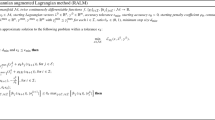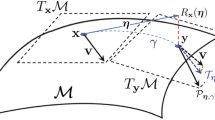Abstract
Optimization problems on unknown low-dimensional structures given by high-dimensional data belong to the field of optimizations on manifolds. Though recent developments have advanced the theory of optimizations on manifolds considerably, when the unknown low-dimensional manifold is given in the form of a set of data in a high-dimensional space, a practical optimization method has yet to be developed. Here, we propose a neural network approach to these optimization problems. A neural network is used to approximate a neighborhood of a point, which will turn the computation of a next point in the searching process into a local constraint optimization problem. Our method ensures the convergence of the process. The proposed approach applies to optimizations on manifolds embedded into Euclidean spaces. Experimental results show that this approach can effectively solve optimization problems on unknown manifolds. The proposed method provides a useful tool to the field of study low-dimensional structures given by high-dimensional data.







Similar content being viewed by others
Notes
In general the whole manifold cannot be defined by the zero set of a given function, see (Boothby 1986).
References
Absil PA, Malick J (2012) Projection-Like retractions on matrix manifold. SIAM J Optim 22(1):135–158
Absil PA, Baker CG, Gallivan KA (2007) Trust-region methods on Riemannian manifolds. Found Comput Math 7(3):303–330
Absil PA, Mahony R, Sepulchre R (2008) Optimization algorithms on matrix manifolds. Princeton University Press, New Jersy
Adler RL, Dedieu J, Margulies JY, Martens M, Shub M (2002) Newtons method on Riemannian manifolds and a geometric model for the human spine. IMA J Numer Anal 22(3):359–390
Baker CG, Absil PA, Gallivan KA (2008) An implicit trust-region method on Riemannian manifolds. IMA J Numer Anal 28(4):665–689
Boothby WM (1986) An introduction to differentiable manifolds and riemannian geometry. Academic Press, Orlando
Bothina ES (2012) An active-set trust-region algorithm for solving constrained multi-objective optimization problem. Appl Math Sci 6(33):1599–1612
Christopher GB (2008) Riemannian manifold trust-region methods with applications to eigenproblems, Ph. D thesis, Florida State Universtity
Coleman T, Branch MA, Grace A (1999) Matlab optimization toolbox users guide, 3rd edn. Math Works, Natick
Gabay D (1982) Minimizing a differentiable function over a differential manifold. J Optim Theory Appl 37(2):177–219
Gould NIM, Robinson DP (2010) A second derivative SQP method: global convergence. SIAM J Optim 20(4):2023–2048
Huang W, Absil PA, Gallivan KA (2015) A Riemannian symmetric rank-one trust-region method. Math Program 150(2):179–216
Ishteva M, Absil PA, Huffel SV, Lathauwer LD (2011) Tucker compression and local optima. Chemometrics Intell Lab Syst 106(1):57–64
Ishteva M, Absil PA, Dooren PV (2013) Jacobi algorithm for the best low multilinear rank approximation of symmetric tensors. SIAM J Matrix Anal Appl 34(2):651–672
Jiang B, Dai YH (2015) A framework of constraint preserving update schemes for optimization on Stiefel manifold. Math Program 153(2):535–575
Li J, Bian W, Tao D, Zhang C (2013) Learning colours from textures by sparse manifold embedding. Signal Process 93(6):1485–1495
Lin T, Zha H (2008) Riemannian manifold learning. IEEE Trans Pattern Anal Machine Intell 30(5):796–809
Ring W, Wirth B (2012) Optimization methods on Riemannian manifolds and their application to shape space. Soc Indian Autom Manuf J Optim 22(2):596–627
Robert HN (1992) Theory of the backpropagation neural network. In Brace, H. & Co. Neural Networks for Perception, (2), Orlando, FL, USA
Selvan SE et al (2012) Descent algorithms on oblique manifold for source-adaptive ICA contrast. IEEE Trans Neural Netw Learn Syst 23(12):1930–1947
Seung HS, Lee D (2000) The manifold ways of perception. Science 290:2268–2269
Smith ST (1994) Optimization techniques on Riemannian manifolds, in Hamiltonian and Gradient Flows, Algorithms and Control, A. Bloch, ed., Fields Inst. Commun 3. American Mathematical Society, Providence, RI, 113-136
Tyagi H, Vural E, Frissard P (2013) Tangent space estimation for smooth embeddings of Riemannian Manifolds. Inf Inference 2(1):69–114
Udriste C (1994) Convex functions and optimization methods on Riemannian manifolds. Kluwer Academic Publishers Group, Dordrecht
Wang Z (2004) A generalized trust region SQP algorithm for equality constrained optimization. Rice University, Houston
Yang Y (2007) Globally convergent optimization algorithms on Riemannian manifolds: uniform framework for unconstrained and constrained optimization. J Optim Theory Appl 132(2):245–265
Yoon K et al (2013) Specific evidence of low-dimensional continuous attractor dynamics in grid cells. Nature Neurosci 16:1077–1084
Acknowledgements
Chen was supported by Beijing Municipal Commission of Education Foundation (KM201811232015) and Beijing Postdoctoral Research Foundation (ZZ201965), Wang was supported by National Natural Science Foundation of China (51777012), Qiao was supported by National Natural Science Foundation of China (61890930), and Zou was supported by a Simons Foundation Collaboration Grant for Mathematicians (416937).
Funding
This study was funded by the National Natural Science Foundation of China (51777012, 61890930), Beijing Municipal Commission of Education Foundation of China (KM201811232015), Beijing Postdoctoral Research Foundation (ZZ-201965), Simons Foundation Collaboration Grant for Mathematicians (416937), Beijing Natural Science Foundation (4202026), Key research and cultivation projects of promote the classified development of Universities (2121YJPY211).
Author information
Authors and Affiliations
Corresponding author
Ethics declarations
Conflict of interest
Qili Chen declares that she has no conflict of interest. Jiuhe Wang declares that he has no conflict of interest. Junfei Qiao declares that he has no conflict of interest. Yi Ming Zou declares that he has no conflict of interest.
Ethical approval
This article does not contain any studies with human participants or animals performed by any of the authors.
Informed consent
N/A
Additional information
Publisher's Note
Springer Nature remains neutral with regard to jurisdictional claims in published maps and institutional affiliations.
Rights and permissions
About this article
Cite this article
Chen, Q., Wang, J., Junfei, Q. et al. Optimizations on unknown low-dimensional structures given by high-dimensional data. Soft Comput 25, 12717–12723 (2021). https://doi.org/10.1007/s00500-021-06064-x
Accepted:
Published:
Issue Date:
DOI: https://doi.org/10.1007/s00500-021-06064-x




